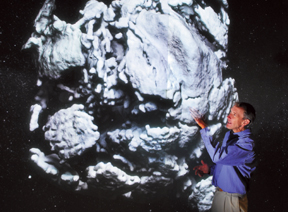
The stunning amount of forest devastation at Tunguska a century ago in Siberia may have been caused by an asteroid only a fraction as large as those postulated in previously published estimates, Sandia supercomputer simulations suggest.
“The asteroid that caused the extensive damage was much smaller than we had thought,” says principal investigator Mark Boslough (1433) of the impact that occurred June 30, 1908. “That such a small object can do this kind of destruction suggests that smaller asteroids are something we should consider. Their smaller size indicates such collisions are not as improbable as we had previously believed.”
Because smaller asteroids approach Earth statistically more frequently than larger ones, he says, “We should make more efforts at detecting the smaller ones than we have till now.”
The new simulation — which more closely matches the widely known facts of destruction than earlier models — shows that the center of mass of an asteroid exploding above the ground is transported downward at speeds faster than sound. It takes the form of a high-temperature jet of expanding gas called a fireball.
This causes stronger blast waves and thermal radiation pulses at the surface than would be predicted by an explosion from a point-source at the height where the burst was initiated.
“Our understanding was oversimplified,” says Mark. “We no longer have to make the same relatively primitive assumptions because present-day supercomputers allow us to do things with high resolution in
3-D. Everything gets clearer as you look at things with more refined tools.”
The new interpretation also accounts for the fact that winds were amplified above ridgelines where trees tended to be blown down, and that the forest at the time of the explosion, according to foresters, was not healthy. Thus previous scientific estimates had overstated the devastation caused by the asteroid, since topographic and ecologic factors contributing to the result had not been taken into account.
Revising deflection strategies
“There’s actually less devastation than previously thought,” says Mark, “but it was caused by a far smaller asteroid. Unfortunately, it’s not a complete wash in terms of the potential hazard, because there are more smaller asteroids than larger ones.”
Mark and colleagues achieved fame more than a decade ago by accurately predicting that that the fireball caused by the intersection of the comet Shoemaker-Levy 9 with Jupiter would be observable from Earth.
Simulations show that the material of an incoming asteroid is compressed by the increasing resistance of Earth’s atmosphere. As it penetrates deeper, the increasingly dense wall of air causes it to explode as an airburst that precipitates the downward flow of heated gas.
Because of the additional energy transported toward the surface by the fireball, what scientists had thought to be an explosion between 10 and 20 megatons was more likely only three to five megatons. The physical size of the Tunguska asteroid, says Mark, would depend on its speed and whether it is porous or nonporous, icy or waterless, and other material characteristics.
“Any strategy for defense or deflection should take into consideration this revised understanding of the mechanism of explosion,” says Mark.
The work was presented at the American Geophysical Union meeting in San Francisco on Dec. 11. A paper on the phenomenon, coauthored by Dave Crawford (1541) and titled “Low–altitude airbursts and the impact threat” has been accepted for publication in the International Journal of Impact Engineering.
The research was paid for by Sandia’s Laboratory Directed Research and Development office.